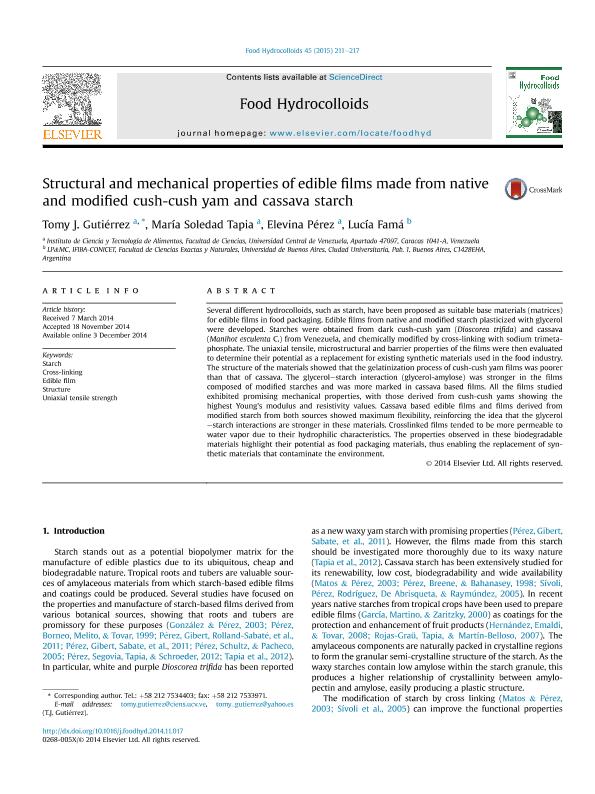Mostrar el registro sencillo del ítem
dc.contributor.author
Gutiérrez Carmona, Tomy José

dc.contributor.author
Tapia, María Soledad
dc.contributor.author
Pérez, Elevina
dc.contributor.author
Fama, Lucia Mercedes

dc.date.available
2018-05-30T14:07:22Z
dc.date.issued
2015-03
dc.identifier.citation
Gutiérrez Carmona, Tomy José; Tapia, María Soledad; Pérez, Elevina; Fama, Lucia Mercedes; Structural and mechanical properties of edible films made from native and modified cush-cush yam and cassava starch; Elsevier; Food Hydrocolloids; 45; 3-2015; 211-217
dc.identifier.issn
0268-005X
dc.identifier.uri
http://hdl.handle.net/11336/46583
dc.description.abstract
Several different hydrocolloids, such as starch, have been proposed as suitable base materials (matrices) for edible films in food packaging. Edible films from native and modified starch plasticized with glycerol were developed. Starches were obtained from dark cush-cush yam (Dioscorea trifida) and cassava (Manihot esculenta C.) from Venezuela, and chemically modified by cross-linking with sodium trimetaphosphate. The uniaxial tensile, microstructural and barrier properties of the films were then evaluated to determine their potential as a replacement for existing synthetic materials used in the food industry. The structure of the materials showed that the gelatinization process of cush-cush yam films was poorer than that of cassava. The glycerol-starch interaction (glycerol-amylose) was stronger in the films composed of modified starches and was more marked in cassava based films. All the films studied exhibited promising mechanical properties, with those derived from cush-cush yams showing the highest Young's modulus and resistivity values. Cassava based edible films and films derived from modified starch from both sources showed maximum flexibility, reinforcing the idea that the glycerol-starch interactions are stronger in these materials. Crosslinked films tended to be more permeable to water vapor due to their hydrophilic characteristics. The properties observed in these biodegradable materials highlight their potential as food packaging materials, thus enabling the replacement of synthetic materials that contaminate the environment.
dc.format
application/pdf
dc.language.iso
eng
dc.publisher
Elsevier

dc.rights
info:eu-repo/semantics/openAccess
dc.rights.uri
https://creativecommons.org/licenses/by-nc-sa/2.5/ar/
dc.subject
Starch
dc.subject
Cross-Linking
dc.subject
Edible Film
dc.subject
Structure
dc.subject.classification
Alimentos y Bebidas

dc.subject.classification
Otras Ingenierías y Tecnologías

dc.subject.classification
INGENIERÍAS Y TECNOLOGÍAS

dc.title
Structural and mechanical properties of edible films made from native and modified cush-cush yam and cassava starch
dc.type
info:eu-repo/semantics/article
dc.type
info:ar-repo/semantics/artículo
dc.type
info:eu-repo/semantics/publishedVersion
dc.date.updated
2018-04-27T18:52:34Z
dc.journal.volume
45
dc.journal.pagination
211-217
dc.journal.pais
Países Bajos

dc.journal.ciudad
Amsterdam
dc.description.fil
Fil: Gutiérrez Carmona, Tomy José. Universidad Central de Venezuela; Venezuela. Consejo Nacional de Investigaciones Científicas y Técnicas; Argentina
dc.description.fil
Fil: Tapia, María Soledad. Universidad Central de Venezuela; Venezuela
dc.description.fil
Fil: Pérez, Elevina. Universidad Central de Venezuela; Venezuela
dc.description.fil
Fil: Fama, Lucia Mercedes. Consejo Nacional de Investigaciones Científicas y Técnicas; Argentina. Universidad de Buenos Aires. Facultad de Ciencias Exactas y Naturales. Departamento de Física. Laboratorio de Polímeros y Materiales Compuestos; Argentina
dc.journal.title
Food Hydrocolloids

dc.relation.alternativeid
info:eu-repo/semantics/altIdentifier/url/http://www.sciencedirect.com/science/article/pii/S0268005X14004275
dc.relation.alternativeid
info:eu-repo/semantics/altIdentifier/doi/http://dx.doi.org/10.1016/j.foodhyd.2014.11.017
Archivos asociados
